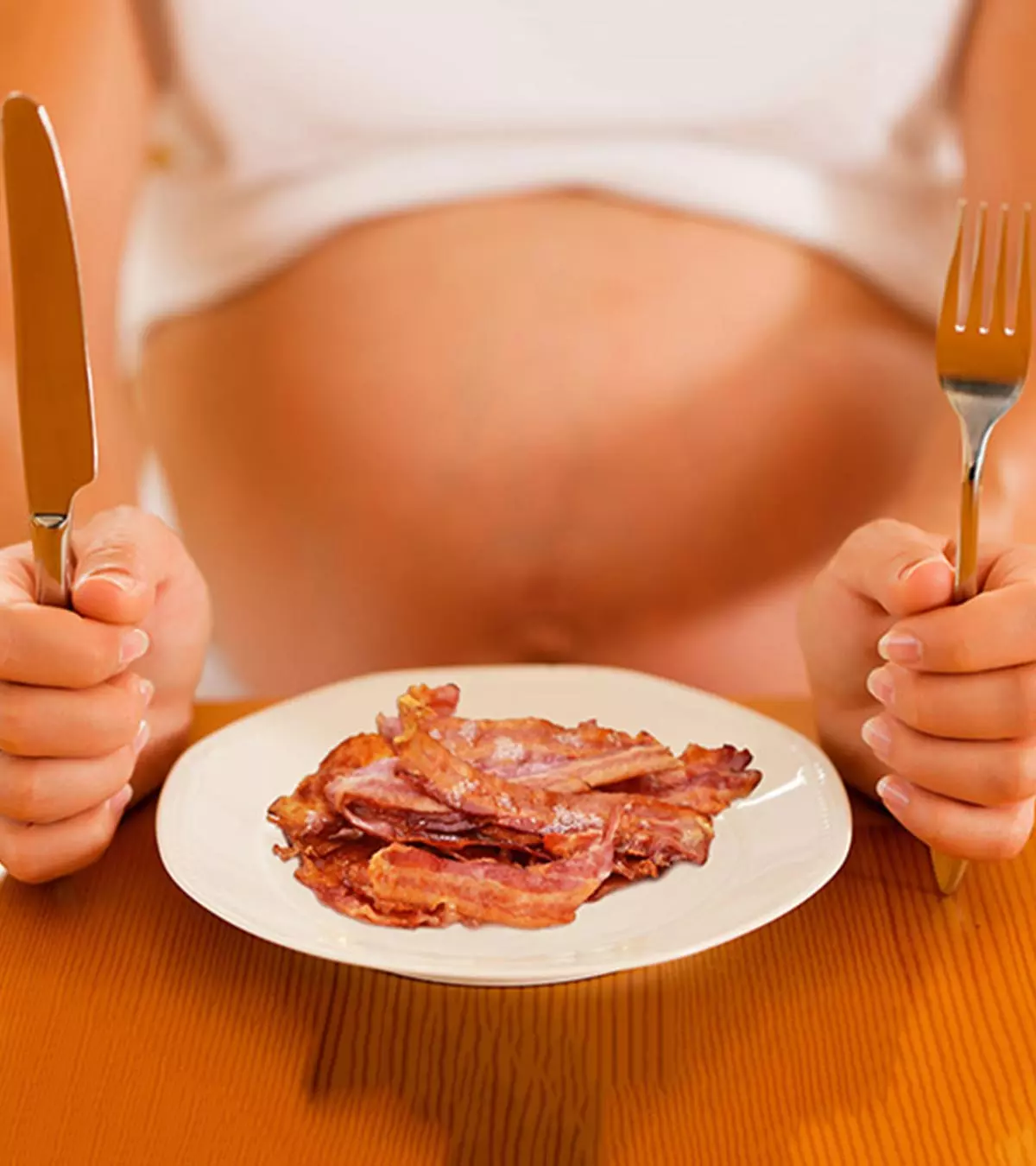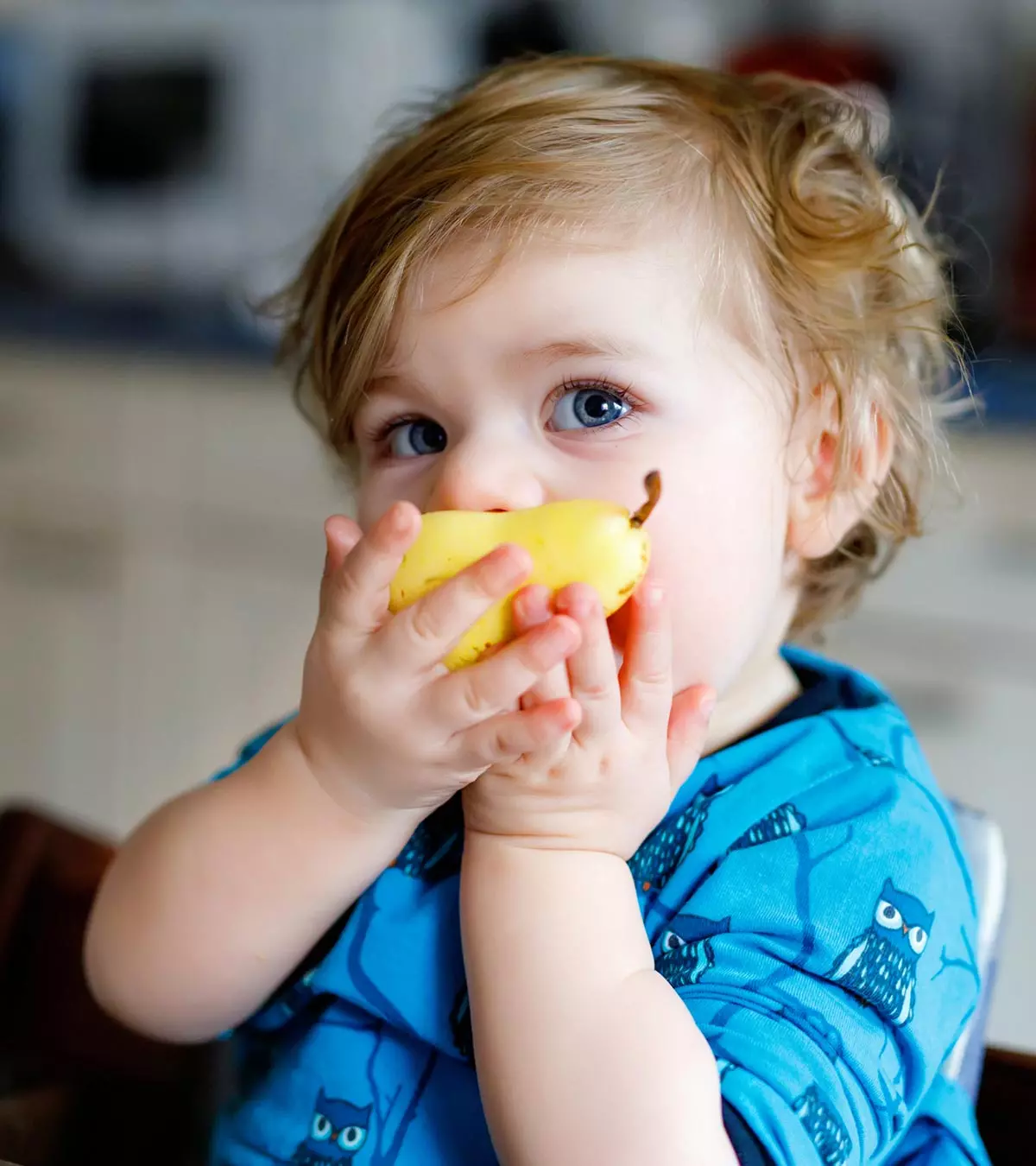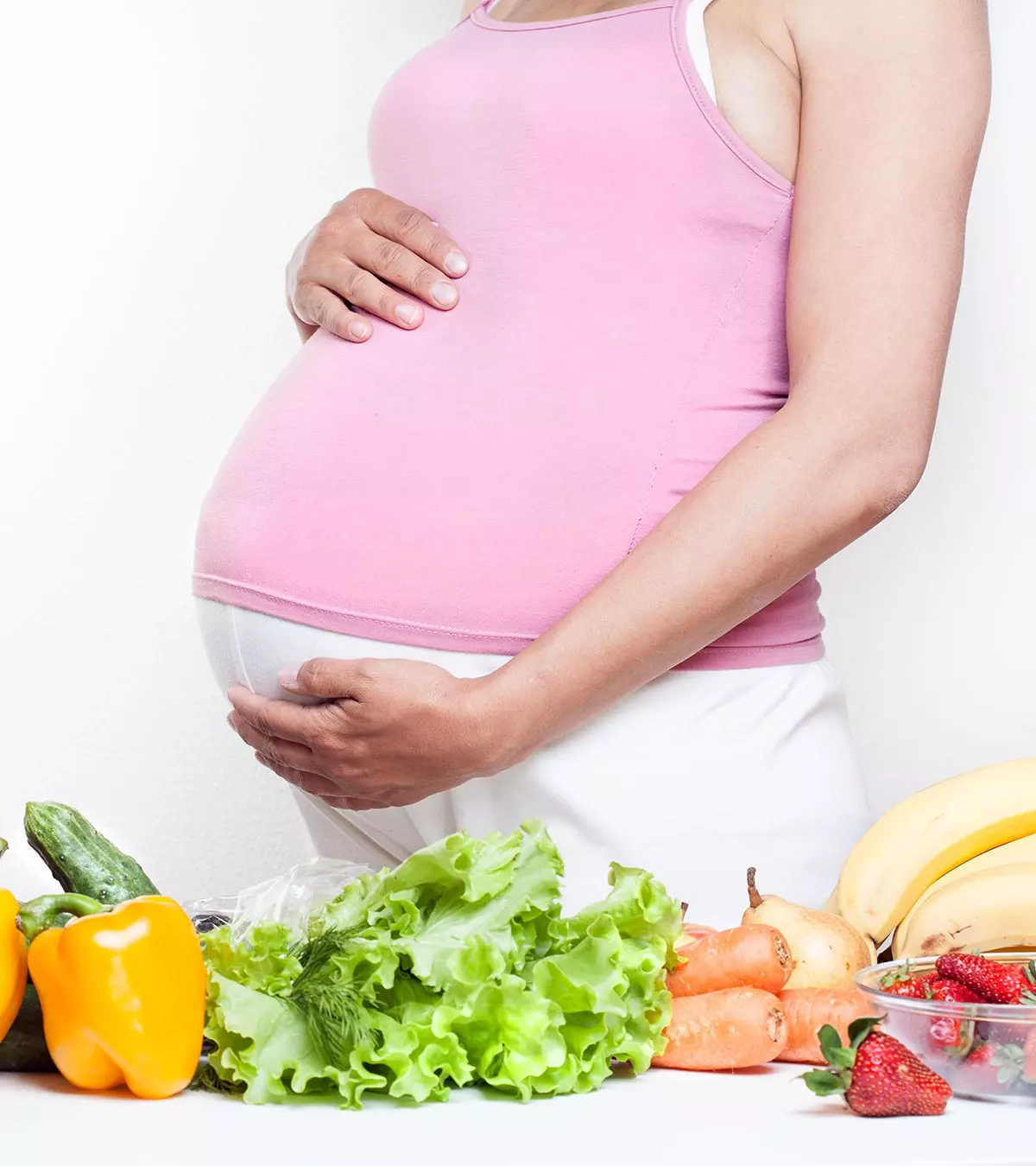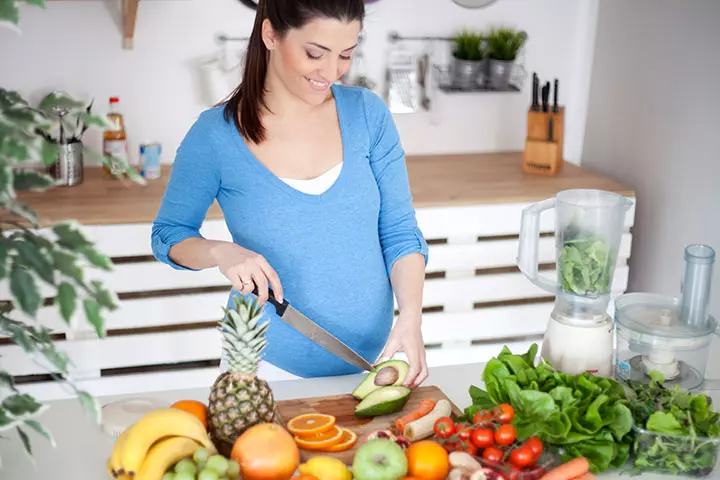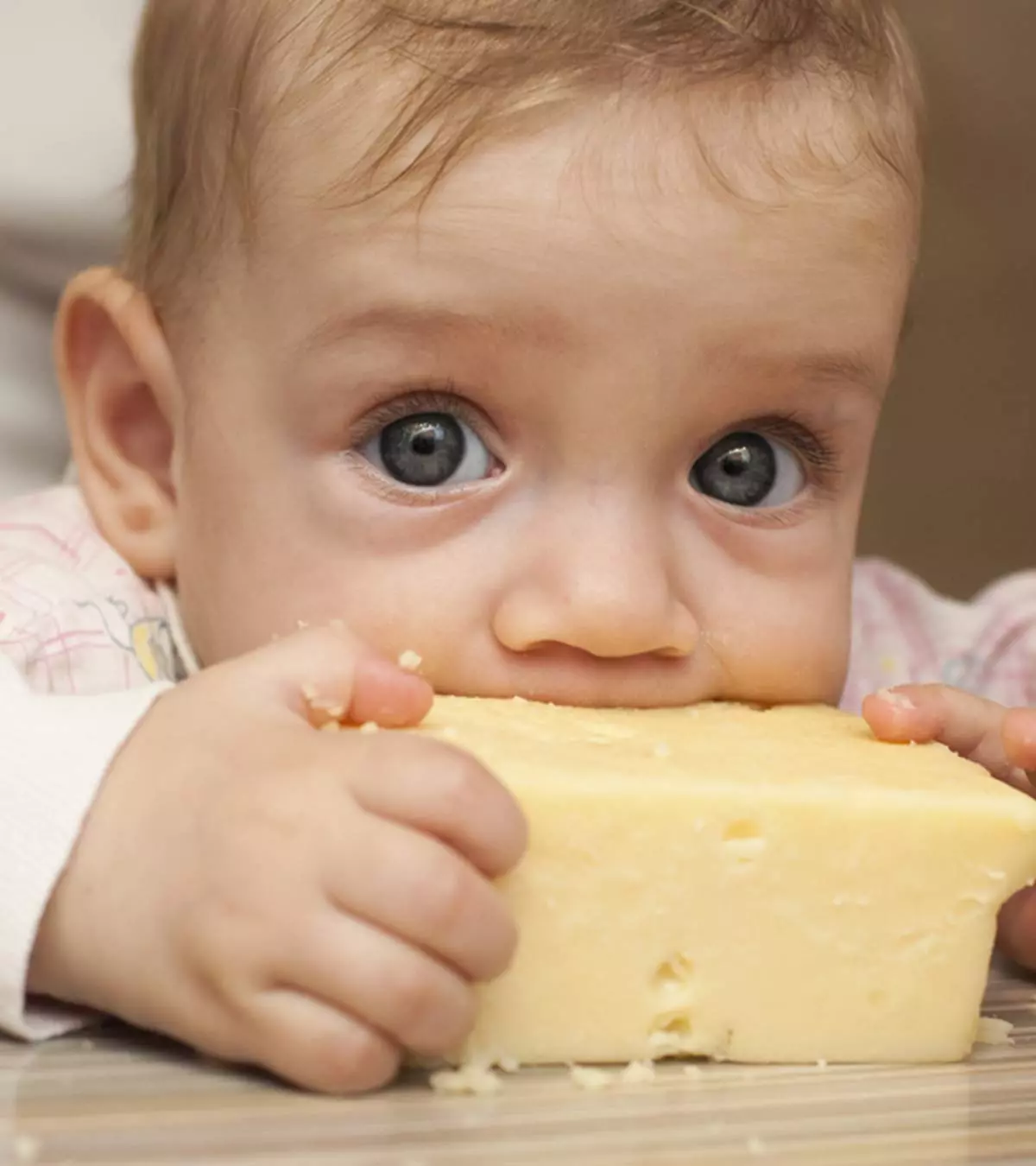
Image: Shutterstock
Many people love cheese and believe that cheese makes their food taste better. It is easy to eat and digest and quite nutritious. Moreover, cheese is a popular snack choice for many parents due to its availability and taste. But is cheese good for babies? Read this post to discover cheese’s advantages and potential drawbacks for children. Also, learn the appropriate age and amount and some homemade cheese recipes for kids.
Key Pointers
- Cheese is a good source of proteins, calcium, minerals, and vitamins, and can be a nutritious part of a balanced diet for babies.
- It is recommended to begin introducing cheese to babies between 7 to 8 months of age, but consulting a pediatrician beforehand is best.
- Cheese can be used as a topping for infant foods such as crackers, toast, or pancakes.
- Lentil and vegetable soup with cheese and cheese omelet are quick, tasty, and nutritious meal options for babies.
- Other meal options include sweet potato-cheese mash, grilled cottage cheese, and cheddar cheese toast.
Is Cheese Good For Babies?
Cheese can be a part of a healthy, balanced diet for babies and young children as it can provide important nutrients like calcium, protein, and vitamins (1). Cheese has essential micronutrients, vitamins A, D, B12, and minerals such as calcium, magnesium,potassium, and phosphorus (2). These nutrients can support the nutritional needs of a growing baby.
When Can Babies Eat Cheese?
There is no definite recommended age when babies can begin eating cheese. The US Food and Drug Administration (FDA) has cleared cheese to be among the first foods for a baby at the age of six months (3). The American Academy of Pediatrics (AAP) recommends including cheese in a baby’s diet around the age of seven to eight months (4)(5).
Speak to your pediatrician before feeding cheese to the baby, especially if you have a family history of dairy allergy or if the baby has any other allergic condition like eczema or asthma.
Start with a small thin strip of cheese when you feed it to your baby for the first time. If cheese suits the baby, then increase the quantity gradually. Avoid cheese made from unpasteurized milk before your baby turns 12 months, as these cheese types could contain listeria bacteria (6).
Listeria is a gram-positive bacteria that can cause listeriosis, a foodborne illness that can cause flu-like symptoms. According to the US Food and Drug Administration (FDA), about 1,600 individuals are diagnosed with listeriosis annually, and their hospitalization rate is 94%.
How Much Cheese Can Babies Eat?
There is no fixed quantity of cheese that a baby should eat. The amount of cheese can vary as per the baby’s age. According to AAP, up to one-fourth (quarter) cup of diced cheese a day can make an ideal snack for babies between the ages of 8-12 months (5). The quantity may be increased to half a cup after the completion of 12 months (7).
Do note a baby can eat a quantity less than the recommended one. Also, older babies and toddlers may be able to eat a bit of extra cheese. Keep cheese a part of healthy balanced diet of the child and do not overfeed.
Benefits Of Cheese
Cheese is made from milk, and thus contains essential nutrients.
- Vitamin D: It is essential for the proper absorption of calcium. Calcium, together with vitamin D, helps in the growth of the baby’s skeletal system.
- Vitamin-B12: Plays a role in several biochemical processes important for growth.
- Other vitamins: Vitamins like riboflavin and niacin are required for healthy growth, development, and sustenance (8).
- Sphingolipids: The compound could help maintain cell membranes and may protect cells from harmful environmental factors. Sphingolipids research is mostly limited to animals(9).
- Anti-inflammatory: Cheese may have anti-inflammatory properties as well. A review of 52 clinical studies, published in the year 2017, deduced that dairy products, in general, have anti-inflammatory effects (10).
- Probiotics: The presence of gut-friendly probiotics in cheese could help maintain healthy gut microbiota, which may be beneficial for the developing baby’s digestive system (11).
In spite of its benefits, not all cheese is the same, and it is good to know how to pick cheese for babies.
Children above the age of 12 months can eat a wider variety of cheese. You may start by introducing a small quantity of cheese and seeing if the toddler tolerates it. If the toddler enjoys the cheese and the body accepts it, then you can consider making the cheese a part of the child’s diet.
If you have any doubt about introducing new foods or if your toddler has allergies, or if your child always displays intolerance towards new foods, then consult a pediatrician before introducing a new type of cheese.
Cheese is of several varieties, and it is good to know the ones that a baby can eat.
Cheese Varieties For Babies
Before you pick cheese for your baby, it is essential to know that there are two types of cheese available in the market, namely natural cheese and processed cheese.
Natural cheese is attained through natural fermentation of milk. Processed cheese contains natural cheese, salt, emulsifiers, added flavors, and preservatives in it. Natural cheese is good for babies due to the absence of any additives. Processed cheese is high in sodium content.
| Cheese suitable for babies younger than 12 months | Cheese to avoid by babies younger than 12 months |
|---|---|
| Cheddar ParmesanEdam Colby Colby Jack Swiss Mozzarella Monterey Jack Romano Babybel Provolone Red Leicester Cheshire Jarlsberg Gouda Lancashire Double Gloucester Grana Padano Cottage Cheese Ricotta Mascarpone Cream cheese | Brie Camembert Chevre Queso Blanco Queso Fresco Danish Blue Stilton Saga Gorgonzola Roquefort Wensleydale |
How To Buy Cheese For Babies?
Keep the following checklist in mind while selecting cheese for babies:
- The cheese must be made of full-fat, pasteurized milk.
- Babies should not eat mold-ripened soft cheeses, such as brie or camembert.
- Do not give them blue-veined cheese (soft) such as Roquefort, as it poses a high risk of carrying listeria. The same holds true for goat’s milk cheese (ripened).
 Quick tip
Quick tipHow To Introduce Cheese To A Baby?
It is generally good to introduce cheese to a baby when they are already eating other finger foods. The following are some tips for adding cheese to a baby’s diet:
- Grate the cheese into strings, and then cut the strings into smaller pieces. Small pieces of stringed cheese minimize the risk of choking (12) (3).
- Begin with mild cheese such as mild cheddar or cottage cheese. The baby may not like strong-flavored cheese.
- If the baby does not seem to like the taste of cheese alone, then serve it along with some other food that they eat; for instance, pasta or teething biscuit. You can also try delicious macaroni and cheese recipes for babies.
- Melted and cooled cheese with boiled or pureed vegetables is also a nutritious option for babies.
- Soft and creamy cheese like ricotta can be added to vegetable soups to improve its palatability.
It is essential to observe caution while introducing cheese to the baby.
Precautions To Take While Giving Cheese To Baby
Follow the below precautions to rule out any side effects of eating cheese:
- Consult your pediatrician before you start cheese for your baby if they have shown symptoms of milk allergy or lactose intolerance in the past.
- Wait for three to five days after introducing cheese for the first time and do not introduce any new food during this period. It will help you pick any signs of allergy or intolerance.
- If you notice any symptoms of allergy, then consult a doctor immediately. The common allergy symptoms are hives, upset stomach, and vomiting. Severe cases could cause anaphylaxis, a situation where breathing is impaired (13).
How To Store Cheese?
Cheese stays best when stored whole. So, if you are buying a small piece of cheese, it’s good to eat it as soon as possible. However, larger pieces would need to be stored. The following are some tips for the storage of cheese.
- Store the cheese in the salad drawer that runs at a slightly higher temperature. Moreover, the confined space will retain humidity levels and helps keep the cheese fresh. However, do not store salad items with cheese, as it can lead to the transfer of harmful bacteria to the cheese.
- Store hard cheeses (most of them) at 8-15 degrees Celsius. Warmer temperatures can cause the cheese to mature.
- Almost all cheese stays fresh at 80% relative humidity. But if storing it at a specific humidity level is not possible, cover the cheese with a clean, damp cloth and then store.
- The waxed paper in which cheese is supplied helps keep the cheese in the right condition. It allows the cheese to breathe. On the contrary, cling film tends to let too much moisture build up, encouraging molds to grow on the surface of the cheese. Therefore, cover only the cut surface with cling film while allowing the rind to breathe.
An atmosphere that is too dry or too moist leads to undesirable changes in the cheese. For example, excessive mold growth might pave way for the growth of harmful bacteria, such as listeria, brucella, salmonella, and E. coli, leading to health implications.
Cheese Recipes For Babies
The recipes shared below range from being basic to advanced. It will help you provide a variety of cheese dishes to your baby.
1. Cheese as topping
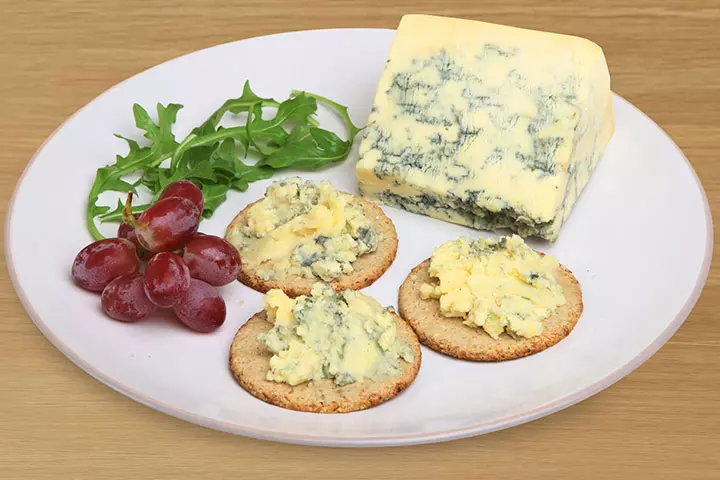
The simplest way to incorporate cheese to your baby’s diet is to use it as a topping over biscuits, crackers, bread, or pancake. A perfect idea for an evening snack for babies.
2. Eggplant and tomato puree with parmesan and mozzarella cheese

Moving ahead than topping, is the incorporation of cheese into vegetable purees. It can make a soulful midday meal for your baby, who is not yet ready to eat grains.
You will need:
- 300g or 10oz eggplant
- 2 tomatoes
- 1 potato (small)
- 30g mozzarella
- 2tsp olive oil
- Parmesan cheese (grated, for serving)
How to:
- Wash all the vegetables thoroughly and dry them with a dry cotton cloth.
- Peel the skin of the eggplant and cut it into two halves. Remove all the seeds (as much as possible) and then cut the two halves into smaller cubes.
- Peel the skin of the tomatoes and cut them into small pieces. Remove all the seeds from the pieces. Similarly, peel the skin of the potato and cut it into small cubes/pieces.
- Put all these vegetables into a steamer kept on medium flame and set the timer for steam cooking at 15 minutes. Vegetables can be considered cooked if they can be minced with a spoon
- Cut the mozzarella cheese into cubes and place it into a blender. Blend the cheese into a smooth paste.
- Add the boiled vegetables to the blender as well.
- Blend the cheese paste with vegetables to make a smooth puree. Add olive oil and blend the puree again.
- Serve the puree in a bowl and garnish it with grated parmesan cheese.
 Things to know
Things to know3. Lentil and vegetable soup with cheese

This is a step towards advanced foods that you give to your baby. This delectable recipe is a perfect light dinner for your baby since it is healthy and delicious.
You will need:
- 1 chopped onion
- 1 chopped garlic
- 2 celery stalks
- 1 cup corn kernels
- 2 chopped potatoes
- 4 chopped carrots
- 70g or 2.4oz red lentils
- 500ml or 17fl.oz fresh vegetable stock
- 2 tbsp olive oil
- 2 tbsp cream cheese
- Handful of chopped fresh coriander
How to:
- Wash the vegetables and leave them to dry.
- Peel the potatoes and onions. Peel the rough outer layer of the carrot. Chop the vegetables into small pieces.
- Take a large cooking pot and add one tablespoon of olive oil to it. Keep the pan over medium heat and let the oil get heated.
- Once the oil is heated, add the chopped vegetables such as onion, garlic, celery, potatoes, corn kernels, and carrots into the pot.
- Fry the vegetables for 5-10 minutes and keep cooking until the onions get soft and brown. The vegetables too should get soft and mushy.
- As you get the desired softness in vegetables, add the lentils, and the stock into the pan.
- Let the mixture boil for 5-8 minutes and then reduce the heat. Simmer with the lid on for 20-25 minutes, until the vegetables turn soft enough to be mashed with a spoon.
- Once the vegetables are cooked, switch off the flame and let the mixture cool down.
- After the mixture is cooled, pour it into a blender. Blend everything together until you get a smooth puree.
- Now take a flat pan and add this puree to it. Add one cup of water, which will help convert puree to soup. Bring the mixture to boil and then switch off the flame.
- Serve the soup in a bowl, layering it with cream cheese and chopped coriander.
4. Sweet potato and cheese mash
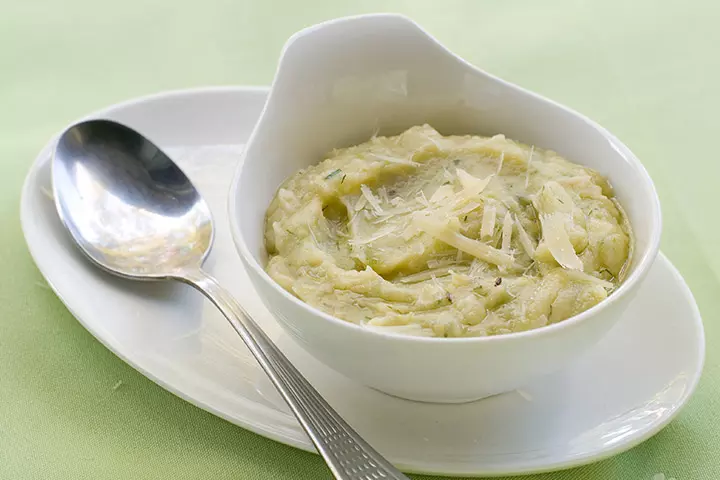
Your baby will likely love the smooth texture of this preparation. It can be a good lunch-time option.
You will need:
- 2 sweet potatoes (medium-sized each)
- 1 carrot (large)
- 25g or 0.8oz Parmesan cheese
- 30g or 1oz cottage cheese
How to:
- Chop the carrots and potatoes into small pieces and boil until tender.
- Let the vegetables cool. Once cooled, put the vegetables in a blender along with cheese and blend it into a smooth puree.
- Serve in a bowl.
5. Mini grilled cottage and cheddar cheese toast

This recipe is ideal for toddlers. This preparation can be served for breakfast as it has an ideal balance of carbohydrates, proteins, and healthy fats, which can keep the baby going throughout the day.
You will need:
- 2 slices of brown bread
- 2 tsp unsalted butter
- 5 cups shredded cheddar cheese
- 1 cup shredded cottage cheese
How to:
- Preheat the oven to 200°F.
- Line a big baking sheet with foil.
- Use a cooking spray to mist the grill lightly.
- Cut the bread slices into smaller sizes. You can even cut them into different shapes using a cookie cutter.
- Brush both sides of the slices with butter.
- Place about a spoonful of cheddar cheese mixed with cottage cheese on top of the bread slices. Spread the mixture on the entire slice. Cover the slice spread over with mixture with other slice and press to seal together.
- Cook the toast on the grill until both sides turn light brown.
- Serve the toast warm.
6. Cheese omelet
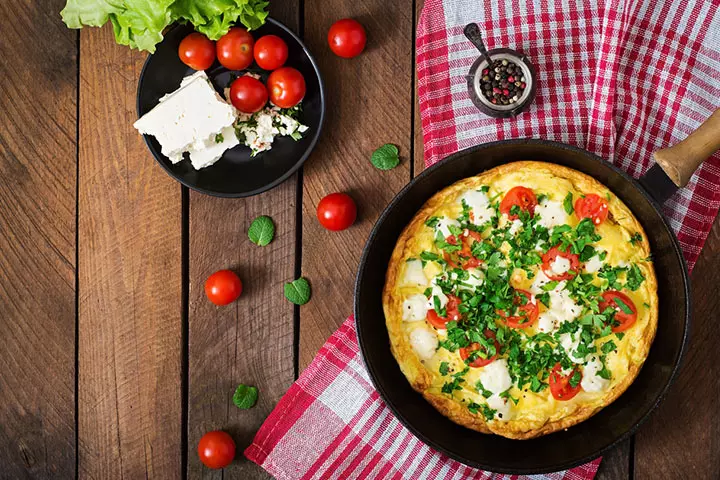
Once your baby gets accustomed to cheese, you can start adding it to different food items like eggs. This recipe makes a healthy choice for finger food.
You will need:
- 1 organic egg
- 1 tsp milk
- 1 tbsp Mascarpone cheese
- 1 tsp virgin olive oil
How to:
- Whisk the egg and milk in a bowl.
- Melt the butter in a pan over medium heat. Once the butter bubbles, pour the egg mixture.
- Spread the egg mixture evenly on the pan.
- Let the omelette cook until the egg mixture holds together.
- Sprinkle the shredded cheese and fold the omelet in half.
- Cook for 30 more seconds.
- Cut it into bite-size pieces and serve.
7. Cheesy cottage cheese pasta

This quick and easy recipe is ideal for older toddlers who will likely enjoy the same foods as adults.
You will need:
- 1 cup cooked pasta
- ½ cup cooked carrots
- ½ cup cooked capsicum
- 1 chopped onion (small)
- 1 chopped tomato (medium)
- 30g or 1 oz shredded cottage cheese
- 1 tbsp oil
- 10g or 0.35 oz grated Parmesan cheese
- Salt (according to taste)
How to:
- Take a pan and add oil to it. Put the pan on medium flame.
- Once the oil is heated, add chopped onions and fry them until light brown.
- Add tomato and salt. Cook until the tomatoes turn mushy.
- Once the tomatoes are cooked, add cottage cheese, cooked pasta, and remaining vegetables.
- Cook for 5 minutes.
- Once cooked, serve it warm with grated cheese mixed with pasta.
8. Cheesy rice
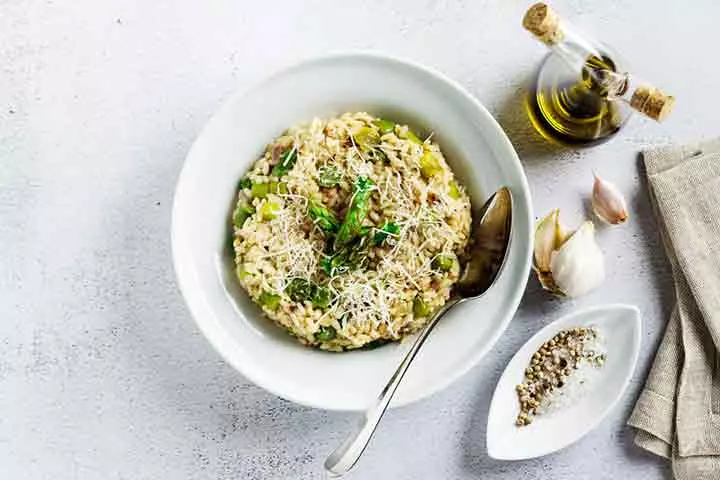
Toddlers love this recipe, making it an ideal choice for a midday lunch or an evening dinner, especially considering rice is a staple in their daily diet.
You will need:
- 2 onions (medium)
- 1 cup rice
- 1 green capsicum (large)
- 3 tbsp of butter or ghee
- 1 cup cabbage
- 2-3 cubes cheese (grated)
- ½ tsp sugar
- 1 tsp pepper powder
- Salt to taste
How to:
- Cook the rice over low heat, being careful not to overcook it. After cooking the rice, drain the water and set it aside.
- Slice the onion, capsicum, and cabbage into thin, long strips.
- In a pan, melt the butter and sauté the onions for about 2 minutes.
- Cook for five minutes after adding the capsicum and cabbage to the pan.
- Season the vegetables with sugar, pepper powder, and salt, and toss thoroughly.
- Divide the rice into two layers. Create the first layer in an oven-proof dish with cooked rice, followed by a layer of sautéed vegetables, and top with grated cheese.
- Add the second layer of rice and sautéed vegetables, then top it with cheese.
- Place the dish in a warm oven or microwave for five minutes until the cheese melts. Serve hot.
Frequently Asked Questions
1. Can I give cheese to my baby every day?
Yes, you can give cheese to your baby every day. However, you must keep in mind that it counts as dairy consumption; therefore, restrict other dairy products. At one year, babies need around 16-24 ounces of dairy products (14). Therefore, you should offer them other healthy food options as well to maintain a balanced diet.
2. Why can babies have cheese but not milk?
Milk contains proteins that can be difficult for a baby to digest. However, in dairy products like cheese and yogurt, these proteins are denatured (broken down) into smaller pieces that are easier to digest (15). Hence, babies can have cheese but not milk.
3. When can I introduce cheese and yogurt to my baby?
After six months, you can introduce cheese and yogurt to your baby, provided they are eating various iron-rich foods (16). You can also try out different cheese and yogurt recipes for your baby and serve them as meals or snacks.
4. Is cheese too salty for babies?
Processed cheese is salty and has high sodium content. It is not recommended to give processed cheese to babies (16). However, you may offer other natural cheese variants to them.
You may prepare cheese recipes for babies from the age of six months. However, it is advised to seek a pediatrician’s opinion if you have a family history of dairy allergies. Cheese is rich in calcium, proteins, and other essential vitamins and minerals to support the growth and development of the baby. You may add cheese as a part of a balanced diet and try not to overfeed. It is recommended to give full-fat, pasteurized cheese to babies and avoid soft cheeses. You may add finely grated cheese or melted cool cheese to vegetable purees for the baby.
Infographic: Precautions For Feeding Cheese To Babies
Including cheese in a baby’s meal can be a healthful way to provide them with essential nutrients like calcium and protein. However, to minimize potential health problems, it’s crucial to pick the ideal kinds of cheese and introduce them gradually. See the infographic below for safety measures to take while feeding cheese to infants.
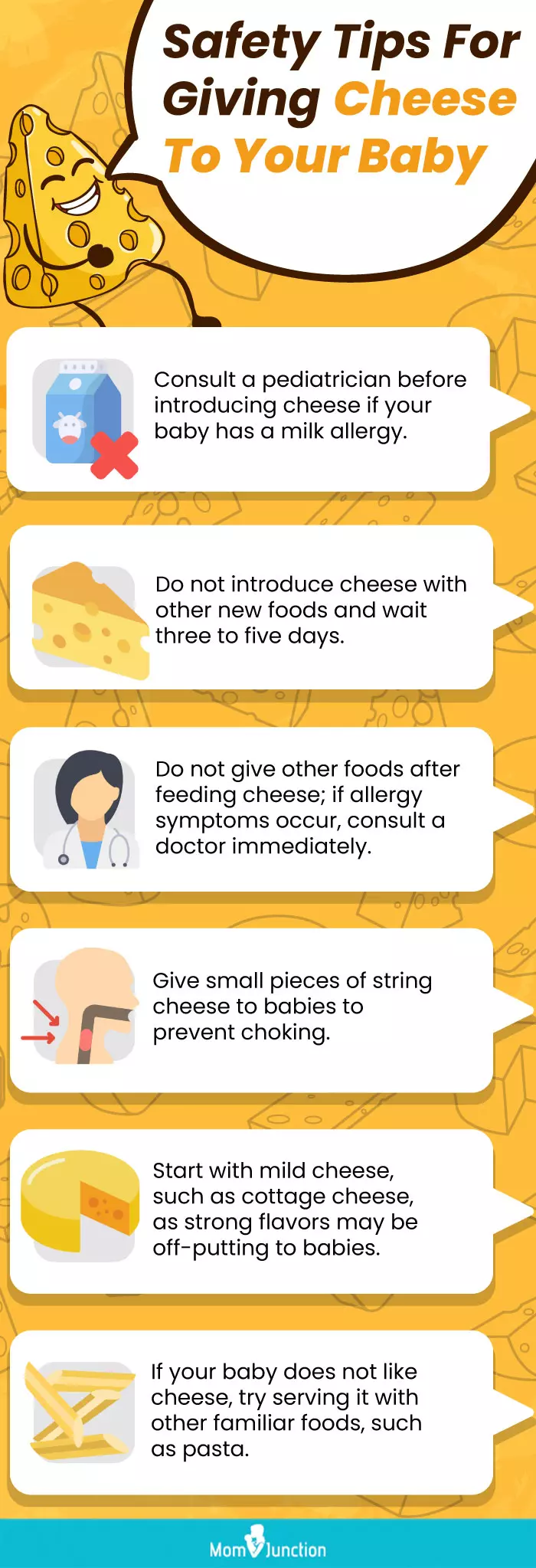
Illustration: Momjunction Design Team
Illustration: Cheese For Babies: When To Introduce Benefits And Recipes
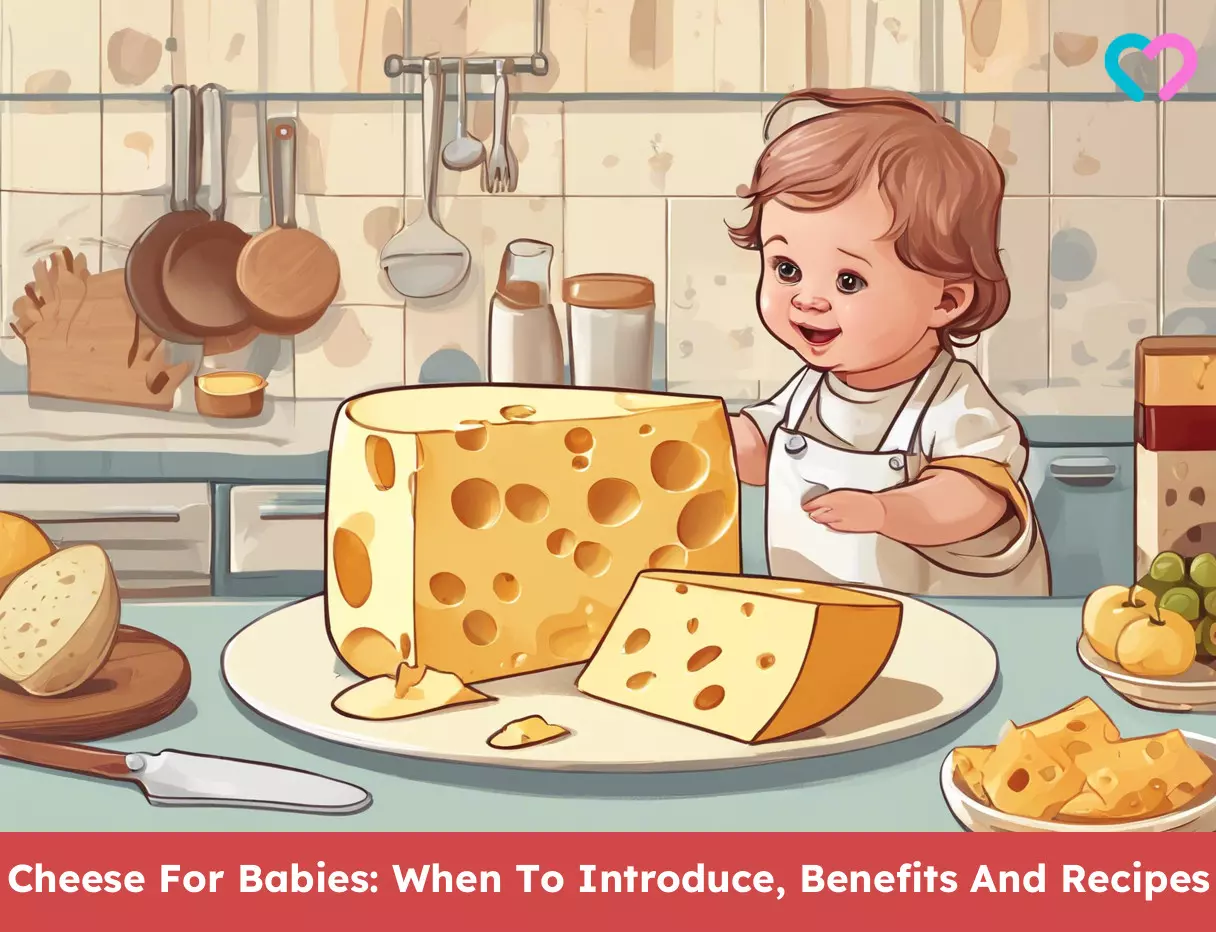
Image: Stable Diffusion/MomJunction Design Team
References
1. Foods to Giving Babies and Young Children; National Health Service, UK (2018)
2. Nutrients in Cheese; Dairy Council of California
3. When, What, and How to Introduce Solid Foods; Centers for Disease Control and Prevention
4. Feeding Your Baby Solid Food;Nationwide Children’s Hospital
5. Sample Menu for an 8 to 12 Month Old; American Academy of Pediatrics
6. Listeria; Centres for Disease Control and Prevention
7. Feeding Your Toddler – Ages 1 to 3 Years; Cleveland Clinic
8. Riboflavin; National Institutes of Health
9. Vesper et al., Sphingolipids in food and the emerging importance of sphingolipids to nutrition; National Centre for Biotechnology Information
10. Bordoni et al., Dairy products and inflammation: A review of the clinical evidence; National Centre for Biotechnology Information (2017)
11. F. Bhat and Hina Bhat, Milk and Dairy Products as Functional Foods: A Review;International Journal of Dairy Science
12. Choking Prevention; C.S. Mott Children’s Hospital
13. Milk and Dairy Allergy; American College of Allergy, Asthma and Immunology
14. Feeding Your 1- to 2-Year-Old; Nemours KidsHealth
15. Feeding Your Baby and Toddler (Birth to Age Two); C.S. Mott Children’s Hospital
16. Yogurt, cheese and milk; Government of Newfoundland and Labrador
17. Storage and Handling of Cheese and Yogurt; Dairy Council of California
Community Experiences
Join the conversation and become a part of our nurturing community! Share your stories, experiences, and insights to connect with fellow parents.
Read full bio of Moloko Mehlape
Read full bio of Swati Patwal
Read full bio of Rohit Garoo
Read full bio of Anindita Ghatak














